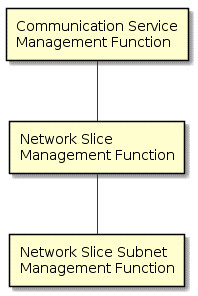Network Slicing and 3GPP Service and Systems Aspects (SA) Standard
Tony Saboorian (tony.saboorian@huawei.com) and Amanda Xiang (amanda.xiang@huawei.com), Huawei
IEEE Softwarization, December 2017
Network slicing is an important capability to bring network resource utilization efficiency, deployment flexibility and support fast growing over the top (OTT) application and services. 3GPP is considering network slicing as one of the key features of 5G. It is spending significant effort to develop comprehensive network slice related standards in various working groups, particularly SA1 (service requirements), SA2 (architecture), SA3 (security) and SA5 (network management). This article gives an overview of current 3GPP Service and Systems Aspects (SA) standard status for the development of mobile network slicing for 3GPP Release 15 whose target completion date is June 2018.
1. 3GPP architecture for network slicing
The 3GPP SA2 Working Group, responsible for overall system architecture, is currently working on specifying the 5G Core (5GC) architecture with Network Slicing being a main feature of 5GC. Technical Specification (TS) 23.501 defines Stage-2 System Architecture for the 5G System which includes Network Slicing. Technical Specification (TS) 23.502 defines procedures for the 5G System. Technical Specification (TS) 23.503 defines Policy and Charging Control Framework for the 5G System. The work on these Technical Specifications is ongoing with target completion date being December 2017. Figure 1 depicts the non-roaming reference architecture. Figure 2 depicts an example of Network Slicing.
Figure 1: 5G network architecture (non-roaming)
Figure 2: Example of Network Slices
1.1 3GPP Network Slice Definition
A network slice is viewed as a logical end-to-end network that can be dynamically created. A given User Equipment (UE) may access to multiple slices over the same Access Network (e.g. over the same radio interface). Each slice may serve a particular service type with agreed upon Service-level Agreement (SLA). In this article we provide highlights of 3GPP Network Slicing as being defined in TS 23.501 in SA2. A Network Slice is defined within a Public Land Mobile Network (PLMN) and includes the Core Network Control Plane and User Plane Network Functions as well as the 5G Access Network (AN). The 5G Access Network may be:
- A Next Generation (NG) Radio Access Network described in 3GPP TS 38.300, or
- A non-3GPP Access Network where the terminal may use any non-3GPP access to reach the 5G core network via a secured IPSec/IKE tunnel terminated on a Non-3GPP InterWorking Function (N3IWF).
TS 23.501 defines Network Function, Slice, and Slice Instance as follows:
Network Function: A 3GPP adopted or 3GPP defined processing function in a network, which has defined functional behavior and 3GPP defined interfaces. (Note: A network function can be implemented either as a network element on a dedicated hardware, as a software instance running on a dedicated hardware, or as a virtualized function instantiated on an appropriate platform, e.g. on a cloud infrastructure.)
Network Slice: A logical network that provides specific network capabilities and network characteristics.
Network Slice instance: A set of Network Function instances and the required resources (e.g. compute, storage and networking resources) which form a deployed Network Slice.
1.2 Identification and selection of a Network Slice
Identification of a Network Slice is done via the Single Network Slice Selection Assistance Information (S-NSSAI). The NSSAI (Network Slice Selection Assistance Information) is a collection of S-NSSAIs. Currently 3GPP allows up to eight (8) S-NSSAIs in the NSSAI sent in signaling messages between the UE and the Network. This means a single UE may be served by at most eight Network Slices at a time. The S-NSSAI signaled by the UE to the network, assists the network in selecting a particular Network Slice instance. An S-NSSAI is comprised of:
- A Slice/Service type (SST), which refers to the expected Network Slice behaviour in terms of features and services;
- A Slice Differentiator (SD), which is an optional information that complements the Slice/Service type(s) to differentiate amongst multiple Network Slices of the same Slice/Service type.
The S-NSSAI may be associated with a PLMN (e.g., PLMN ID) and have network-specific values or have standard values. An S-NSSAI is used by the UE in access network in the PLMN that the S-NSSAI is associated with.
1.2.1 Standardized Slice/Service type (SST) values
SA2 has defined some standardized SST values in TS 23.501. These SST values are to reflect the most commonly used Slice/Service Types and will assist with global interoperability for slicing. Currently, SA2 has defined a short characteristic for eMBB SST, however, this may change while 3GPP Rel15 is being finalized. Other SSTs are still work in progress.
Standardized SST values
|
Slice/Service type |
SST value |
Characteristics |
|---|---|---|
|
eMBB (enhanced Mobile Broadband)
|
1 |
Slice suitable for the handling of 5G enhanced Mobile broadband, useful, but not limited to the general consumer space mobile broadband applications including streaming of High Quality Video, Fast large file transfers etc. |
|
URLLC (ultra- Reliable Low Latency Communications) |
2 |
TBD |
|
MIoT (Massive IoT) |
3 |
TBD |
1.3 General aspects of network slicing in TS 23.501
The Access and Mobility Management Function (AMF) instance that is serving the UE is common (or logically belongs) to all the Network Slice instances that are serving the UE. Other network functions, such as the Session Management Function (SMF) or the User Plan Function (UPF), may be specific to each Network Slice.
The Network Slice instance selection for a UE is normally triggered as part of the registration procedure by the first AMF that receives the registration request from the UE. The AMF retrieves the slices that are allowed by the user subscription and interacts with the Network Slice Selection Function (NSSF) to select the appropriate Network Slice instance (e.g., based on Allowed S-NSSAIs, PLMN ID, etc.). This could result in a change of AMF if needed.
A Protocol Data Unit (PDU) Session is associated to one S-NSSAI and one DNN (Data Network Name). The establishment of a PDU session within the selected instances-NSSAI is triggered when the AMF receives a Session Management message from UE. The AMF discovers candidate Session Management Functions (SMF) using multiple parameters including the S-NSSAI provided in the UE request and selects the appropriate SMF. The selection of the User Plane Function (UPF) is performed by the SMF and uses the S-NSSAI. The Network Repository Function (NRF) is used for the discovery of the required Network Functions using the selected Network Slice instance – the detailed procedures are specified in 3GPP TS 23.502. The data transmission can take place after a PDU session to a Data Network is established in a Network Slice. The S-NSSAI associated with a PDU Session is provided to the AN, and to the policy and charging entities, to apply slice specific policies.
For roaming scenarios, S-NSSAI values applicable in the Visited PLMN (VPLMN) are used to discover a SMF instance in the VPLMN and in Home–Routed deployments S-NSSAI values applicable in the Home PLMN (HPLMN) are also used to discover a SMF instance in the HPLMN.
2. Network Slicing Management and Orchestration
3GPP SA5 is the 3GPP telecom management working group. By the time this article is written, SA5 has completed the study on management and orchestration on network slicing (TR28.801) and just started the normative specification work for release 15 based on this study. It is expected to be completed by the second quarter of 2018, including:
- Network slice concepts, use cases and requirements (TS 28.530)
- Provisioning of network slicing for 5G networks and services TS (TS 28.531)
- Assurance data and Performance Management for 5G networks and network slicing
- Fault Supervision for 5G network and network slicing
The following description highlights management and orchestration aspects of network slicing in 3GPP SA5 TR 28.801. However, these may be updated in the SA5 Normative Specifications based on the ongoing development of the SA2 technical specifications (as described above).
2.1 General management and orchestration aspects of network slicing defined in TR28.801:
Based on 3GPP SA2 TS23.501, SA5 has defined different management aspects for network slices in TR28.801 as listed below:
- Managing a complete Network Slice Instance (NSI) is not only managing all the functionalities but also the resource necessary to support certain set of communications service.
- An NSI not only contains Network Functions (NFs), e.g belonging to Acces Network (AN) and Core Network (CN), but also the connectivity between the NFs.
If the NFs are interconnected, the 3GPP management system contains the information relevant to connections between these NFs such as topology of connections, individual link requirements (e.g. QoS attributes), etc. For the part of the Transport Network (TN) supporting connectivity between the NFs, the 3GPP management system provides link requirements to the management system that handles the part of the TN supporting connectivity between the NFs. - NSI can be composed of network slice subnets of Physical Network Functions and/or Virtualized Network Functions.
2.2 Network Slice Instance lifecycle management
3GPP TR28.801 has introduced the network slice instance lifecycle management as depicted below in Figure 2, considering it independent of the network service instance which is using the network slice instance. Typically a network slice instance is designed (preparation phase), then it is instantiated (Instantiation, Configuration and Activation phase), then it is operated (Run Time phase) and finally it may be decommissioned when the slice is no longer needed (Decommissioning phase). These different phases would be part of the “Network Slice Management Function” mentioned below in Fig 3.
Figure 2: Network slice instance lifecycle
TR28.801 introduces 3 management logical functions as illustrated below in Figure 3:
Figure 3: Network slice management functions
- Communication Service Management Function (CSMF):
- Responsible for translating the communication service related requirement to network slice related requirements.
- Network Slice Management Function (NSMF):
- Responsible for management and orchestration of NSI.
- Derive network slice subnet related requirements from network slice related requirements.
- Network Slice Subnet Management Function (NSSMF):
- Responsible for management and orchestration of NSSI.
Conclusion
3GPP is conducting standardization effort holistically on network slicing. This article only gives the introduction of the standard progress from system architecture prospective. Beyond 3GPP SA, 3GPP RAN (Radio Access Network) WGs are also working on how RAN handles network slices. Because Virtualization is one of the enabling technology for network slicing, 3GPP is also closely collaborating with relevant network virtualization standard organizations, such as ETSI NFV ISG, to make sure the network slice can run in the virtualized environment and operators can have a seamless E2E network slice resource management capability including the virtualized resource for the network slices.
References
[1] 3GPP TS 23.501: “System Architecture for the 5G System”
[2] 3GPP TR 28.801: “Study on management and orchestration of network slicing for next generation network”
 Tony Saboorian is a Director in Wireless Research and Standards in Huawei Technologies and leads the Huawei Wireless Network delegations in 3GPP TSG-SA. Before joining Huawei, he was the leader of the wireless core network standards group in Nortel Networks. He has extensive experience in telecommunication research and standardization with emphasis on Wireless Network, SDN and NFV. Mr. Saboorian has worked on various design, planning, architecture and standards projects in Siemens, Nortel Networks, and Huawei. He has contributed to number of telecom standards, held leadership positions in Standards organizations, and is recognized for his contributions to the industry. He received his master’s degree in Electrical and Computer Engineering from Florida Atlantic University.
Tony Saboorian is a Director in Wireless Research and Standards in Huawei Technologies and leads the Huawei Wireless Network delegations in 3GPP TSG-SA. Before joining Huawei, he was the leader of the wireless core network standards group in Nortel Networks. He has extensive experience in telecommunication research and standardization with emphasis on Wireless Network, SDN and NFV. Mr. Saboorian has worked on various design, planning, architecture and standards projects in Siemens, Nortel Networks, and Huawei. He has contributed to number of telecom standards, held leadership positions in Standards organizations, and is recognized for his contributions to the industry. He received his master’s degree in Electrical and Computer Engineering from Florida Atlantic University.
 Amanda Xiang received Master degree of Electrical Engineering from Clemson University. She has been working in mobile communication industry for almost 20 years and worked for various companies such as Ericsson, Motorola, ZTE and Huawei with different technical and leadership roles. She has been participating and contributing industry standard effort for mobile network since 2005, including contribution in WiMAX forum, IEEE802.16, IEEE802.20, 3GPP (SA2, SA1, SA5, RAN2), 3GPP2, WFA, ETSI NFV ISG. Currently she is the senior standard manager of Huawei, and responsible for NFV, network slicing, IoT.
Amanda Xiang received Master degree of Electrical Engineering from Clemson University. She has been working in mobile communication industry for almost 20 years and worked for various companies such as Ericsson, Motorola, ZTE and Huawei with different technical and leadership roles. She has been participating and contributing industry standard effort for mobile network since 2005, including contribution in WiMAX forum, IEEE802.16, IEEE802.20, 3GPP (SA2, SA1, SA5, RAN2), 3GPP2, WFA, ETSI NFV ISG. Currently she is the senior standard manager of Huawei, and responsible for NFV, network slicing, IoT.
Editor:
 Laurent Thiébaut is an End to End Senior Architect at Nokia Networks, Paris, France. His specialties are End to end network architecture, from the interface with the Radio Access Network to the applications, with a focus on IMS/sip based apllications.
Laurent Thiébaut is an End to End Senior Architect at Nokia Networks, Paris, France. His specialties are End to end network architecture, from the interface with the Radio Access Network to the applications, with a focus on IMS/sip based apllications.
Subscribe to IEEE Softwarization
Join our free SDN Technical Community and receive IEEE Softwarization.
Article Contributions Welcomed
Download IEEE Softwarization Editorial Guidelines for Authors (PDF, 122 KB)
If you wish to have an article considered for publication, please contact the Managing Editor at sdn-editor@ieee.org.
Past Issues
IEEE Softwarization Editorial Board
Laurent Ciavaglia, Editor-in-Chief
Mohamed Faten Zhani, Managing Editor
TBD, Deputy Managing Editor
Syed Hassan Ahmed
Dr. J. Amudhavel
Francesco Benedetto
Korhan Cengiz
Noel Crespi
Neil Davies
Eliezer Dekel
Eileen Healy
Chris Hrivnak
Atta ur Rehman Khan
Marie-Paule Odini
Shashikant Patil
Kostas Pentikousis
Luca Prete
Muhammad Maaz Rehan
Mubashir Rehmani
Stefano Salsano
Elio Salvadori
Nadir Shah
Alexandros Stavdas
Jose Verger







